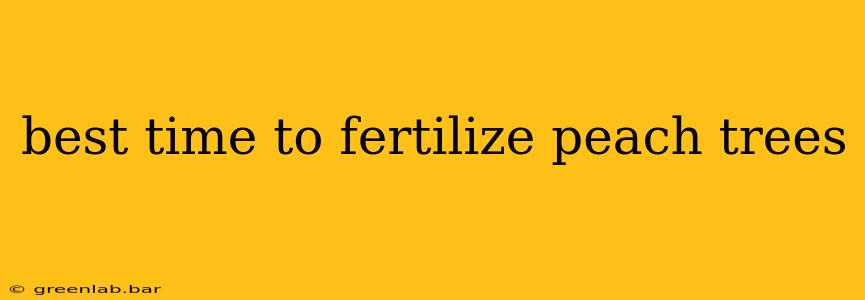Peach trees, renowned for their juicy, sweet fruit, require proper fertilization to thrive and yield a plentiful harvest. Knowing the best time to fertilize is crucial for optimal growth and fruit production. This guide will delve into the ideal fertilization schedule, considering factors like tree age, soil conditions, and your geographic location. We'll explore different fertilizer types and application methods to ensure your peach trees flourish.
Understanding Peach Tree Nutritional Needs
Peach trees are heavy feeders, demanding a balanced supply of essential nutrients throughout their growing cycle. These nutrients, including nitrogen (N), phosphorus (P), and potassium (K), are vital for various aspects of the tree's health and productivity:
- Nitrogen (N): Promotes vigorous leaf and stem growth, contributing to overall tree size and vigor. Nitrogen deficiency can lead to stunted growth and pale leaves.
- Phosphorus (P): Essential for root development, flowering, and fruit set. Phosphorus deficiency can result in poor flowering and reduced fruit production.
- Potassium (K): Crucial for disease resistance, fruit quality, and overall tree health. Potassium deficiency can lead to weakened trees, susceptible to diseases and pests.
The Ideal Time to Fertilize Peach Trees
The best time to fertilize your peach trees is generally in early spring, just as new growth begins. This is typically after the last frost in your area. Applying fertilizer at this time provides the tree with the nutrients it needs for optimal blossom production and fruit development.
However, a single fertilization may not suffice. A split application often proves beneficial:
- Early Spring Application (Late Winter/Early Spring): This application provides the nutrients necessary for robust spring growth and flowering.
- Summer Application (Mid-Summer): A lighter feeding in mid-summer can support fruit development and replenish nutrients used during the initial growth spurt. This second application is optional, particularly if you used a slow-release fertilizer in spring.
Factors Influencing Fertilization Timing
Several factors can influence the precise timing of your fertilization:
- Tree Age: Young peach trees (less than 3 years old) generally require less fertilizer than mature trees. Over-fertilizing young trees can encourage excessive vegetative growth at the expense of fruit production.
- Soil Type: Soil testing is highly recommended. A soil test will determine the existing nutrient levels and guide you in choosing the appropriate fertilizer type and amount. Sandy soils tend to drain quickly, requiring more frequent, but smaller, applications. Clay soils retain nutrients longer, allowing for less frequent fertilization.
- Geographic Location: Climate significantly impacts the timing of bud break and fruit development. In warmer climates, fertilization may begin earlier than in colder regions.
Choosing the Right Fertilizer
Various fertilizers are suitable for peach trees. The best choice will depend on your soil test results and personal preference:
- Granular Fertilizers: These are easy to apply and offer a balanced supply of NPK. Slow-release granular fertilizers are ideal for providing a consistent nutrient supply throughout the growing season.
- Liquid Fertilizers: Liquid fertilizers offer a quicker nutrient uptake but require more frequent applications. They are particularly useful for addressing immediate nutrient deficiencies.
- Organic Fertilizers: Organic fertilizers like compost, manure, or bone meal provide nutrients gradually and improve soil health. They are a sustainable option that benefits the environment.
Application Methods and Dosages
Always follow the fertilizer package instructions for application rates. Over-fertilizing can harm your peach tree, potentially leading to nutrient imbalances and reduced fruit production.
Common application methods include:
- Broadcast Application: Spread the fertilizer evenly around the tree's drip line (the area beneath the outermost branches where water drips).
- Band Application: Apply the fertilizer in a band around the tree trunk, several inches away from the base.
- Top Dressing: Work the fertilizer lightly into the soil's top layer.
Monitoring Your Peach Tree's Health
Regularly monitor your peach tree's health throughout the growing season. Watch for signs of nutrient deficiency, such as yellowing leaves or stunted growth. Adjust your fertilization strategy accordingly, based on the tree's response and your observations.
By understanding your peach tree's nutritional needs and following these guidelines, you'll significantly improve your chances of a bountiful harvest of delicious peaches. Remember, proper fertilization is just one piece of the puzzle; adequate watering, pest management, and proper pruning are equally crucial for healthy, productive peach trees.

